
German postcard. Ross Verlag, No. 3658/3. United Artists. The card depicts a moment in The Three Musketeers (Fred Niblo, 1921), but stems from when Douglas Fairbanks made the sequel to The Three Musketeers: The Iron Mask (Allan Dwan, 1929).

French postcard for the two-part film Les trois mousquetaires (Henry Pouctal, André Calmettes, 1912-1913). Caption: The Stigmata. The film starred Emile Dehelly as D'Artagnan and Nelly Cormon as Milady. The sets were by Emile Bertin.

German postcard by Ross Verlag, no. 1064/3, 1927-1928. Photo: DeWesti Film-Verleih. Ivan Mozzhukhin in Kean (Alexandre Volkoff, 1924).

Dutch postcard by van Leer's Fotodrukindustrie N.V., Amsterdam, no. 351, no. 6. Photo: Metro Goldwyn Mayer (M.G.M.). June Allyson and Gene Kelly in The Three Musketeers (George Sidney, 1948).
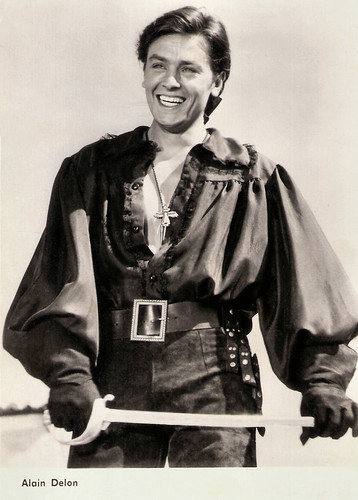
East-German postcard by VEB Progress Film-Vertrieb, Berlin, no. 2480, 1965. Photo: Alain Delon in La tulipe noire/The Black Tulip (Christian-Jaque, 1964).

East-German postcard by Progress Film-Verleih, Berlin, no. 115/76. Photo: Michael York in The Three Musketeers (Richard Lester, 1973).

French postcard by Sonis, no. C. 853. Photo: United Artists. Gérard Depardieu and Jeremy Irons in The Man in the Iron Mask (Randall Wallace, 1998).
The first great success of the romantic drama
Alexandre Davy de La Pailleterie Dumas was born in Villers-Cotterêts (Aisne) in 1802. His father, the French general Thomas Alexandre Dumas, was the son of Antoine Alexandre Davy, marquis de La Pailleterie, and his mother was Marie-Louise-Elisabeth Labouret. In 1806, his father died of a stomach ailment, and Alexandre grew up in rather poor circumstances. The only - rather rudimentary - education he received was from a priest. In spite of this, the young Dumas showed a quick and sharp mind and broadened his knowledge by devouring books.
Dumas initially worked as a third clerk for a local notary but dreamed of Paris. He decided to break with his employer to try his luck in the capital and found a job as a copyist at the Duke of Orléans' secretariat. Dumas began a relationship with a young divorced linen seamstress from Rouen, Marie-Cathérine Labay, with whom he would have a son in 1824, Alexandre Dumas fils, who would also become a writer. Dumas only acknowledged his son in 1831 and acquired custody of his son after a court case. Dumas' mother also moved in with her son during this period and continued to live with him until her death in 1868.
His literary work initially consisted mainly of vaudeville plays and melodramas, which he wrote in collaboration with his friend Adolphe de Leuven, the son of an exiled Swedish nobleman. Their first play, 'La Chasse et l'Amour', was shown in 1825. He also had a hand in another vaudeville piece, entitled 'La noce et l'enterrement'. At first, Dumas had little success. His first great success came in 1829 with the play 'Henri III et sa cour', which can be considered as the first great success of the romantic drama.
The greats of the romantic movement such as Victor Hugo and Alfred de Vigny noticed him. The Duke of Orléans, who had attended the performance, hired Dumas as a librarian at the Palais Royal. Dumas' first success was followed by another successful play, 'Christine' (1830), about Christina of Sweden. These successes made it possible for Dumas to live off his pen and give up his job.
Dumas played an active role in the revolution of 1830, which brought his former employer, the Duke of Orléans, to the throne as the Citizen King Louis Philippe. The revolution caused Dumas to leave the literary scene for a while. He was sent by La Fayette on several missions. However, Dumas became more and more estranged from the government and was even told that it would be good for him to leave France for a while, but Dumas would maintain a close relationship with the Duke of Orléans until his death in 1850.
During this period Dumas still had many successes, for instance with the plays 'Antony' (1831), which was resumed one hundred and thirty times, and 'La Tour de Nesle' (1832). The successes also meant a change of lifestyle for the young writer. He made a good impression, dressed eccentrically, and travelled extensively. In 1840 he married the actress Ida Ferrier, allegedly at the instigation of the Duke of Orléans or through financial manipulation. The marriage, however, did not change Dumas' lifestyle in any way.

Vintage French minicard in the Collection Felix Potin. Photo: Nadar. Portrait of the writer Alexandre Dumas père.
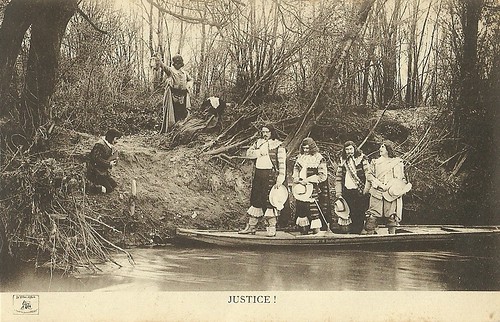
French postcard for the two-part film Les trois mousquetaires (Henry Pouctal, André Calmettes, 1912-1913). Caption: Justice!
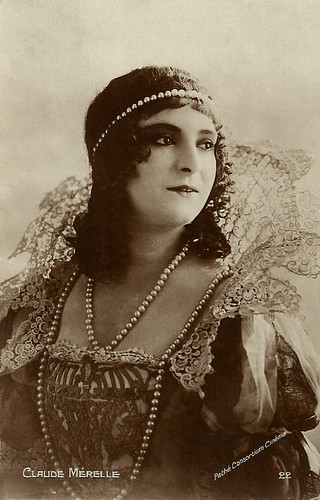
French postcard by Editions Cinémagazine, no. 22. Photo: Pathé Consortium Cinéma. Claude Mérelle as the evil Milady de Winter in Les trois mousquetaires/The Three Musketeers (Henri Diamant-Berger 1921).

French postcard by Editions Cinémagazine, no. 19. Photo: Pathé Consortium Cinéma. Aimé Simon-Girard as D'Artagnan in Les Trois Mousquetaires/The Three Musketeers (Henri Diamant-Berger, 1921).

British postcard by Cinema Art LTD, London. Douglas Fairbanks as D'Artagnan in The Three Musketeers (Fred Niblo, 1921).
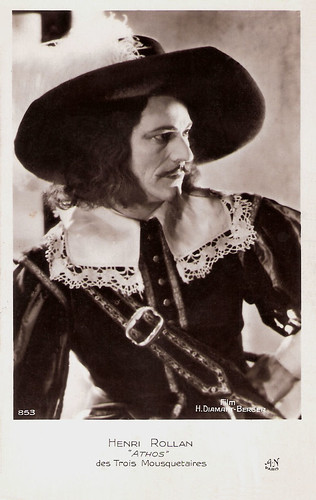
French postcard by A.N., Paris no. 853. Photo: Film H. Diamant-Berger. Henri Rollan as Athos in Les Trois Mousquetaires/The Three Musketeers (Henri Diamant-Berger, 1932).

East-German postcard by VEB Progress Filmvertrieb, Berlin, no. 2481, 1965. Photo: Alain Delon and Virna Lisi in La tulipe noire/The Black Tulip (Christian-Jacque, 1964).
His unbridled imagination and fighting spirit
Alexandre Dumas was not content with playwriting alone. His unbridled imagination and fighting spirit urged him to devote himself to the novel as well. One of Dumas' first attempts at a novel was 'Le capitaine Paul' (1838), a reworking of one of his plays, which he had published as a serial in a newspaper. In the period 1839-1841, Dumas worked with some friends on an eight-volume collection of essays on famous criminals and crimes from European history, including essays on Cesare and Lucrezia Borgia, but also on more recent figures such as Karl Ludwig Sand.
The attention to history is amply reflected in Dumas' best-known novels. Through his friend, the poet Gérard de Nerval, Dumas met the history teacher Auguste Maquet in 1839. The two men entered into a cooperation agreement, whereby Maquet would provide the necessary material for the novels and Dumas would mould the facts into the form of a novel in his own lively way.
The first product of the collaboration was the grand novel 'Les Trois Mousquetaires' (The Three Musketeers) (8 volumes, 1844), based on the memoirs of d'Artagnan written by Gatien de Courtilz de Sandras. The novel tells the adventures of D'Artagnan, Athos, Porthos, and Aramis, who together take on Cardinal de Richelieu for Anna of Austria.
The admirers of this novel were delighted with two sequels, 'Vingt Ans Après' in 1845 (Twenty Years Later) and 'Le Vicomte de Bragelonne ou Dix ans plus tard' from 1848 (The Viscount of Bragelonne or Ten Years Later), of which the third and last part, 'The Man in the Iron Mask', is the most famous. The success of 'The Three Musketeers' was overwhelming, so much so that Dumas was asked if it could also be shown on stage. Dumas was reluctant at first because of several stage failures he had suffered. In the end, however, he gave in, largely on the basis of financial gain.
Immediately after 'The Three Musketeers', in 1844-1845, Dumas published another successful work: 'Le Comte de Monte-Cristo' (The Count of Monte-Christo). While writing this novel, Dumas had a new whim: he had to have a castle that would bear the name Monte-Cristo. And so it came to pass: the castle was built in Le Port-Marly.
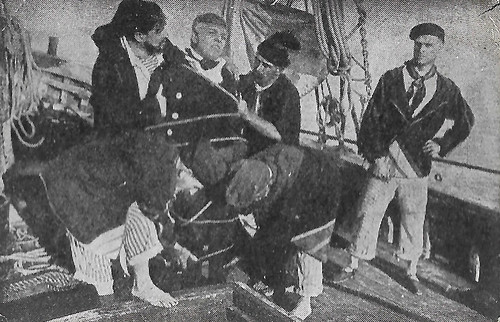
French postcard. Photo: Film d'Art. Léon Mathot as the title character in the French silent serial film Le Comte de Monte-Cristo (Henri Pouctal, 1918).
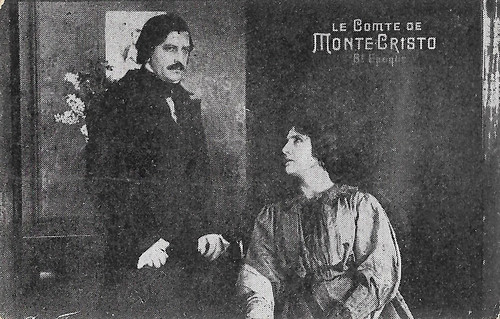
Spanish minicards by Chocolate Amatller, Marca Luna, Series 2. Photo: Film d'Art/Pathé Frères. Léon Mathot as Edmond Dantès/The Count of Monte-Cristo, and Nelly Cormon as Mercedes in Le Comte de Monte-Cristo/The Count of Monte Cristo (Henri Pouctal, 1918).

German postcard. Photo: Nicolas Koline in Kean/Edmund Kean: Prince Among Lovers (Alexander Volkov, 1924).

French postcard by J.R.P.R., Paris, no. 348. Photo: Studio G.L. Manuel Frères. Pierre Batcheff in Le Comte de Monte-Christo/Monte Cristo (Henri Fescourt, 1929).

French postcard by Ed. Chantal, Rueil, no. 25. Photo: C.E.F.C. Lise Delamare in Le Comte de Monte-Cristo/The Count of Monte Christo (Robert Vernay, 1943).

French postcard by A.N., Paris, no. 439. Photo: Engberg. Marcelle Chantal, aka Marcelle Jefferson-Cohn, as the Countess de la Motte in Le Collier de la reine/The Queen's Necklace (Tony Lekain, Gaston Ravel, 1929).

French postcard by A.N., Paris, no. 440. Photo: Engberg. Fernand Fabre as the Count de la Motte in Le collier de la reine/The Queen's Necklace (Tony Lekain, Gaston Ravel, 1929). The film was shot as a silent film, but a soundtrack with music was added afterward. Based loosely on the novel by Alexandre Dumas, The Queen's Necklace, itself inspired by the famous affair of the Queen's Necklace, the film shows Queen Marie-Antoinette (Diana Karenne) caught up in a nefarious plot hatched by the Countess de la Motte.
A castle filled with bums
Alexandre Dumas père is also known for the novels belonging to the Valois cycle. These include 'La Reine Margot' (Queen Margot) (6 volumes, 1845), 'La Dame de Monsoreau' (8 volumes, 1846), and 'Les Quarante-cinq' (10 volumes, 1847-48). Most of Dumas' novels appeared in several instalments in Parisian newspapers, with the aim of reaching the widest possible audience. Together with Eugène Sue, Dumas was one of the masters of the serial novel.
The collaboration between Dumas and Maquet was a very successful one, with Maquet's historical research work forming the basis of Dumas' storytelling. Dumas was a tireless worker and, as a result, the books followed one another in a very short period of time. The popularity of Dumas caused a lot of envy and he was portrayed as an advertising man who earns money at the expense of other hard-working writers. However, Dumas' creative input was of great importance to the final stories. The broad outlines of the stories were provided by Maquet or other writers, but it was Dumas who gave life to the stories by adding details and dialogues.
Dumas' great output in this period is largely explained by his extravagant lifestyle. He had many mistresses and lived on a grand scale. The construction of his castle, the Château de Monte-Cristo, was also an expensive affair. Moreover, Dumas filled the castle with a large number of bums who were only interested in profiting from Dumas and his money. This recklessly expensive way of life eventually left him penniless. His own theatre, the Théâtre Historique, also had to close its doors.
Dumas was very ambitious and sought recognition on several levels. He eagerly competed for a place in the Académie française and for a seat in the Assemblée Nationale. In the revolution year 1848, Dumas also wanted to play a role in politics. He founded the political and historical magazine Mois and made election speeches for a seat in the Chamber of Deputies for the department of Yonne.
In 1851, Dumas decided to move to the Belgian capital Brussels, partly to escape his creditors, but also because as a republican, he was not favoured by the new emperor Napoleon III. However, he did not stay long in Brussels. He returned to Paris at the end of 1853 and founded a newspaper, Le Mousquetaire. Dumas tried to persuade his son to write for the paper, but he refused. Le Mousquetaire survived only until 1857, partly because Dumas had again surrounded himself with a crowd of profiteers who contributed little to the magazine.
In 1858 Dumas fled Paris and the misfortunes he had suffered there, and made several trips. He travelled to Italy to take part in Garibaldi's struggle for independence. He even put his fortune at the disposal of the Italian independence fighter to buy weapons. As a reward, Garibaldi got him an appointment as museum director in Naples. After his four-year stay in Naples, Dumas returned to Paris. After this, Dumas' powers weakened and his successes faded. His plays and novels lost their appeal, partly because of the realism that reigned at the time. He still tried to cling to his faded fame in all kinds of new ways, but eventually, he sank into a kind of withdrawn resignation. Alexandre Dumas passed away in 1870 at his son's house in Puys, near Dieppe.

French postcard by Cinémagazine, no. 278. Aimé Simon-Girard.

French postcard. Photo: Pathé. The three musketeers, Porthos (Charles Martinelli), Aramis (Pierre de Guingand) and Athos (Henri Rollan), and D'Artagnan (Jean Yonnel) in Vingt ans après/The Return of the Musketeers (Henri Diamant-Berger, 1922). In 1921, Henri Diamant-Berger directed Les Trois Mousquetaires and Vingt ans après (literally: Twenty Years After) was the sequel.
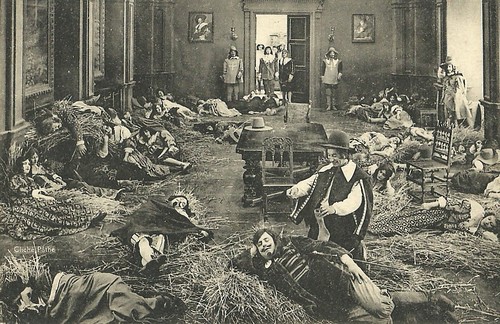
French postcard. Photo: Pathé. Porthos (Charles Martinelli) and his servant Planchet (Armand Bernard) in Vingt ans après/The Return of the Musketeers (Henri Diamant-Berger, 1922).
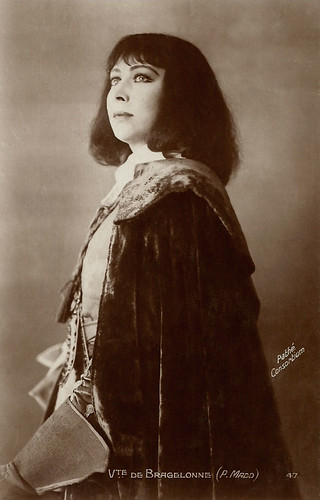
French postcard by Editions Cinémagazine, no. 47. Photo: Pathé Consortium. Pierrette Madd as Raoul, the Vicomte de Bragelonne in Vingt ans après/The Return of the Musketeers (Henri Diamant-Berger, 1922), the sequel to Les Trois mousquetaires/The Three Musketeers (Henri Diamant-Berger, 1921).

East-German postcard by Progress Film-Verleih, no. 19/77. Oliver Reed in The Four Musketeers (Richard Lester, 1974).
More than 200 times filmed
Alexandre Dumas' adventure novels are more than just entertainment literature. Most are both historical novels and feuilletons. Dumas published his novels in sections in the Parisian press. For his contemporaries, the historical novel was the modern form of the epic and Dumas was the master of the genre, thanks to his sense of action and plot twists, and the freedom he took when it came to historical facts. Liveliness and inspiration take precedence over the scrupulous safeguarding of historical accuracy. He combines freedom with historical truth, with attention to the picturesque and the couleur local.
Dumas' historical novels have been filmed more than 200 times. Serials based on his two best-known novels, 'The Three Musketeers' and 'The Count of Monte-Cristo', appeared continuously until 1930. Notable is the French silent film Les Trois Mousquetaires (1921), with Aimé Simon-Girard as d'Artagnan. One of the better-known American versions, The Three Musketeers, also dates from the same year, with Douglas Fairbanks in the role of D'Artagnan. A classic sound version dates from 1948, with Gene Kelly and Lana Turner as D'Artagnan and Milady, and supporting roles for Angela Lansbury and Vincent Price as Queen Anne and Cardinal Richelieu.
Richard Lester directed another version that consisted of two parts, starring Michael York as D'Artagnan, Oliver Reed as Athos, and Richard Chamberlain as Aramis. After The Three Musketeers in 1973, the aptly titled The Four Musketeers followed a year later. It starred Faye Dunaway (Milady), Charlton Heston (Richelieu), Christopher Lee (Rochefort), Geraldine Chaplin (Queen Anne), and Raquel Welch (Constance).
Dumas' own sequel to the heroic tale, 'Twenty Years Later', was a slightly less frequent film adaptation, but the best known was The Return of the Musketeers (Richard Lester, 1989) with much the same cast as the earlier Richard Lester films. Kim Cattrall was added to the cast as Milady's vengeful child.
In 1993, a Disney adaptation followed entitled The Three Musketeers, starring Charlie Sheen as Aramis, Kiefer Sutherland as Athos, Chris O'Donnell as D'Artagnan, Oliver Platt as Porthos, and Tim Curry as Cardinal Richelieu. The young Julie Delpy can be seen as Constance and Rebecca de Mornay as Milady de Winter. The film was a modest success, but the title song 'All for Love' sung by Sting, Rod Stewart, and co-writer Bryan Adams, was a worldwide hit.
The third book of Dumas' musketeer trilogy, 'The Vicomte de Bragelonne', is best known for the part about the Man with the Iron Mask. The best-known film adaptations of this chapter are the silent version The Iron Mask (Allan Dwan, 1929) starring Douglas Fairbanks, James Whale's The Man in the Iron Mask (1939), starring Louis Hayward and Joan Bennett, and The Man in the Iron Mask (Randall Wallace, 1998), starring Leonardo DiCaprio, Jeremy Irons, and Gérard Depardieu.

Dutch postcard by Foto Archief Film en Toneel, no. 3454. Photo: M.G.M. Van Heflin, Gene Kelly, Gig Young, and Robert Coote in The Three Musketeers (George Sidney, 1948), based on the novel by Alexandre Dumas.

Small Romanian collectors card. Photo: Gérard Barray in Les trois mousquetaires/The Three Musketeers (Bernard Borderie, 1961).

East-German postcard by VEB Progress Film-Vertrieb, Berlin, no. 65/75. Photo: Cinerama. Geraldine Chaplin as Queen Anna in The Three Musketeers (Richard Lester, 1973).
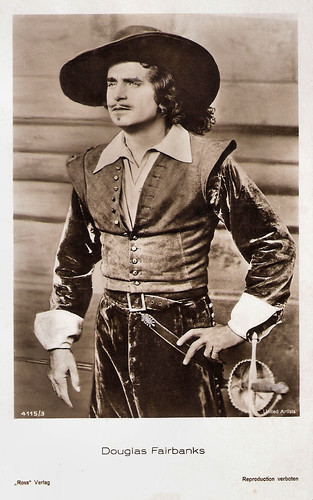
German postcard by Ross Verlag, no. 4115/3, 1929-1930. Photo: United Artists. Douglas Fairbanks in The Iron Mask (Allan Dwan, 1929).

British postcard in the Film Partners Series, London, no. P. 306. Photo: Edward Small Prod. Louis Hayward and Joan Bennett in The Man in the Iron Mask (James Whale, 1939).

British postcard by the London Postcard Company, no. MG 2004 (Series 1 of 9), Portrait #3. Photo: United Artists. Leonardo DiCaprio as Phillippe in The Man in the Iron Mask (Randall Wallace, 1998).

French postcard by Sonis, no. C. 854. Photo: United Artists. Gabriel Byrne, Leonardo DiCaprio, John Malkovich, Gérard Depardieu, and Jeremy Irons in The Man in the Iron Mask (Randall Wallace, 1998).
Sources: Wikipedia (Dutch), and IMDb.
No comments:
Post a Comment